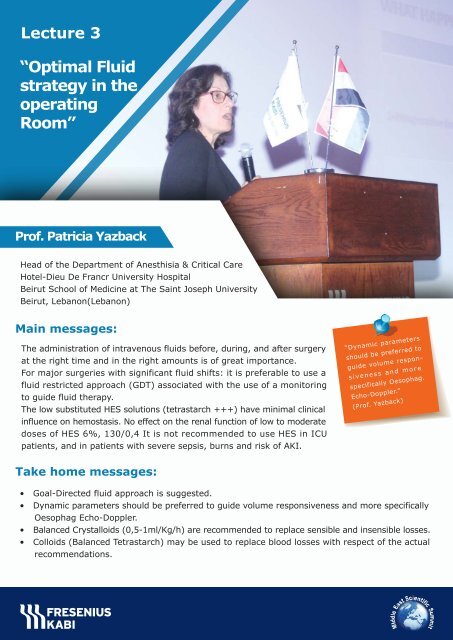Boclet Final_500
Create successful ePaper yourself
Turn your PDF publications into a flip-book with our unique Google optimized e-Paper software.
Lecture 3<br />
“Optimal Fluid<br />
strategy in the<br />
operating<br />
Room”<br />
Prof. Patricia Yazback<br />
Head of the Department of Anesthisia & Critical Care<br />
Hotel-Dieu De Francr University Hospital<br />
Beirut School of Medicine at The Saint Joseph University<br />
Beirut, Lebanon(Lebanon)<br />
Main messages:<br />
The administration of intravenous fluids before, during, and after surgery<br />
at the right time and in the right amounts is of great importance.<br />
For major surgeries with significant fluid shifts: it is preferable to use a<br />
fluid restricted approach (GDT) associated with the use of a monitoring<br />
to guide fluid therapy.<br />
The low substituted HES solutions (tetrastarch +++) have minimal clinical<br />
influence on hemostasis. No effect on the renal function of low to moderate<br />
doses of HES 6%, 130/0,4 It is not recommended to use HES in ICU<br />
patients, and in patients with severe sepsis, burns and risk of AKI.<br />
“Dynamic parameters<br />
should be preferred to<br />
guide volume responsiveness<br />
and more<br />
specifically Oesophag.<br />
Echo-Doppler.”<br />
(Prof. Yazback)<br />
Take home messages:<br />
• Goal-Directed fluid approach is suggested.<br />
• Dynamic parameters should be preferred to guide volume responsiveness and more specifically<br />
Oesophag Echo-Doppler.<br />
• Balanced Crystalloids (0,5-1ml/Kg/h) are recommended to replace sensible and insensible losses.<br />
• Colloids (Balanced Tetrastarch) may be used to replace blood losses with respect of the actual<br />
recommendations.


